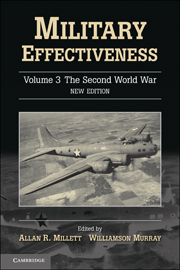Book contents
- Frontmatter
- Contents
- List of Contributors
- Introduction: Military Effectiveness Twenty Years After
- Maps
- 1 The Effectiveness of the Japanese Military Establishment in the Second World War
- 2 The United States Armed Forces in the Second World War
- 3 British Military Effectiveness in the Second World War
- 4 The Italian Armed Forces, 1940–3
- 5 The Dynamics of Volksgemeinschaft: The Effectiveness of the German Military Establishment in the Second World War
- 6 Bitter Victory: French Military Effectiveness during the Second World War
- 7 The Soviet Armed Forces in the Great Patriotic War, 1941–5
- 8 Military Effectiveness in the Second World War
- 9 Challenge and Response at the Operation and Tactical Levels, 1914–45
- 10 The Political and Strategic Dimensions of Military Effectiveness
- Index
2 - The United States Armed Forces in the Second World War
Published online by Cambridge University Press: 05 June 2012
- Frontmatter
- Contents
- List of Contributors
- Introduction: Military Effectiveness Twenty Years After
- Maps
- 1 The Effectiveness of the Japanese Military Establishment in the Second World War
- 2 The United States Armed Forces in the Second World War
- 3 British Military Effectiveness in the Second World War
- 4 The Italian Armed Forces, 1940–3
- 5 The Dynamics of Volksgemeinschaft: The Effectiveness of the German Military Establishment in the Second World War
- 6 Bitter Victory: French Military Effectiveness during the Second World War
- 7 The Soviet Armed Forces in the Great Patriotic War, 1941–5
- 8 Military Effectiveness in the Second World War
- 9 Challenge and Response at the Operation and Tactical Levels, 1914–45
- 10 The Political and Strategic Dimensions of Military Effectiveness
- Index
Summary
Introduction
The effectiveness of the United States armed forces reflected the complex factors that shaped American national security policy before 1945. The United States believed that its geographic isolation between the world's two largest moats and its relative economic self-sufficiency allowed it to avoid alliances and other commitments to foreign nations. Its peacetime military policy provided only for small naval and military constabulary forces designed to police its national domain, to patrol its continental borders, to provide a small base for wartime expansion, and to protect its diplomats and merchant fleet abroad. Historically, the United States chose to avoid the political and economic costs of large standing forces and to assume the risks of its basic policy: to rely upon its large population and industrial capacity to provide the resources for military forces mobilized after the nation went to war. The Second World War proved no exception to this policy, but rather its mot dramatic expression played on a global stage.
In the Second World War the policy of mobilization for a simultaneous war against Japan and the German–Italian alliance created the parameters for organizational effectiveness. The American war effort fell into three broad phases, each characterized by different official and public perceptions of the military challenge and the requirements for successful American policy. Although the United States made some effort at rearmament before the outbreak of the Second World War, it did not make an appreciable change in military emphasis until after the German invasion of Poland in September 1939.
- Type
- Chapter
- Information
- Military Effectiveness , pp. 45 - 89Publisher: Cambridge University PressPrint publication year: 2010
- 1
- Cited by



